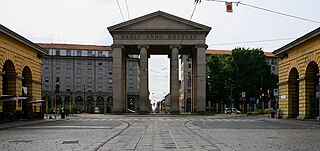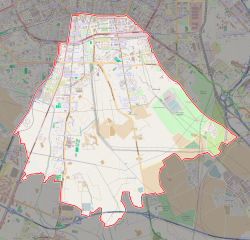
Porta Nuova is one of the main business districts of Milan, Italy in terms of economy, and part of the Zone 2 administrative division. Named after the well-preserved Neoclassic gate built in 1810 on this site, it is now one of Italy's most high-tech and international districts, containing the country's tallest skyscraper: the Unicredit Tower
Porta Monforte is a district ("quartiere") of Milan, Italy, located within the Zone 3 administrative division. It is named after the eponymous city gate, which was added in the 1890s to the existing Spanish walls of the city. The gate was meant to serve as a customs office; the tax booths were designed by Luigi Tormenti and completed in 1889. While the addition of the Monforte city gate was intended to absorb part of the traffic going through Porta Venezia and Porta Vittoria, Porta Monforte remained a minor gate. The gate itself has since been demolished; it was located in what is now Piazza del Tricolore.

Porta Romana is a former city gate of Milan, Italy. In its present form, the gate dates back to the 16th century Spanish walls of Milan; its origins can be traced further back to the Roman walls of the city, which had a corresponding "Roman Gate" roughly in the same area. Porta Romana was the first and the main imperial entrance of the entire city of Milan, as it was the starting point of the road leading to Ancient Rome.

Nosedo is a district ("quartiere") of the city of Milan, Italy. It is part of the Zone 4 administrative division, located south of the city centre. Until 1870, it was an autonomous comune. The name comes from the Latin nocetum, meaning "walnut forest", as walnut trees used to be common in the area.

Rogoredo is a former municipality, currently border district ("quartiere") of the city of Milan, Italy. It is part of the Zone 4 administrative division, and it is located 6–7 km south-east of the city centre. It borders on the Nosedo district to the east, on the Morsenchio district to the north, on the piazzale Corvetto neighbourhood to the north-west, and on the San Donato Milanese comune to the south-east. The name derives from the medieval Latin word robur, meaning "sessile oak, and stands for "oak wood".
Porta Vigentina was one of the city gates in the Spanish walls of Milan, Italy; the gate has since been demolished, but the phrase "Porta Vigentina" is still used to refer to the district ("quartiere") where the gate used to be. The area is part of the Zone 5 administrative division of Milan.
Porta Lodovica was a city gate of the Spanish walls of Milan, Italy, named after Ludovico Sforza. Today, the name refers to the district (quartiere) of Milan where the gate used to be, which is part of the Zone 5 administrative division. The gate was demolished at the end of the 19th century; plans were made to rebuild it inside the Parco di Monza city park in Monza, but they were not implemented.

Chiaravalle is a district (quartiere) of Milan, Italy, part of the Zone 5 administrative division of the city. It is located in the periphery south of the city centre, within the Parco Agricolo Sud Milano nature reserve.

Porta Ticinese is a former city gate of Milan, Italy. The gate, facing south-west, was first created with the Spanish walls of the city, in the 16th century, but the original structure was later demolished and replaced in the early 19th century. The name "Porta Ticinese" is used both to refer to the gate proper and to the surrounding district, part of the Zone 6 administrative division. In the same district there is also a homonymous medieval gate, although in common speech the name "Porta Ticinese" is usually assumed to refer to the 19th century gate.

Porta Genova is a neighborhood ("quartiere") of Milan, Italy, located within the Zone 6 administrative division. The name "Porta Genova" means "Genoa gate"; the district is named after a city gate of the old Spanish Walls of Milan, namely that leading to Genoa, that used to be in what is now Piazza Cantore. The only remnants of the old gate are the small buildings that used to house the customs offices, which replaced the Spanish gate in the 19th Century.

Porta Magenta, formerly known as Porta Vercellina, was one of the city gates of Milan, Italy. The gate was established in the 9th century, with the Roman walls of the city; it was moved with the medieval and Spanish walls, and was finally demolished in the 19th century. The phrase "Porta Magenta" is now used to refer to the district ("quartiere") where the gate used to be; the district is part of the Zone 7 administrative division of Milan, west of the city centre.
Porta Garibaldi is a district (quartier) of Milan, Italy. It is an area located within Zone 9 of the city.

The Zone 2 of Milan is one of the 9 administrative zones of Milan, Italy. In the "sunburst" geometry of the zones of Milan, Zone 2 is the slice that connects the centre to the periphery in the north-east direction.

The Zone 1 of Milan is one of the 9 administrative zones of Milan, Italy.

The Zone 8 of Milan is one of the 9 administrative zones of Milan, Italy. It corresponds to the north-western sector of the city.

The Zone 3 of Milan is one of the 9 administrative zones of Milan, Italy. It corresponds to the north-eastern area of the city.

The Zone 4 of Milan is one of the 9 administrative zones of Milan, Italy. It lies in the south-eastern area of the city.

The Zone 6 of Milan is one of the 9 administrative zones of Milan, Italy. It corresponds to the south-western zone of the city.

The Zone 7 of Milan is one of the 9 administrative zones of Milan, Italy. It is the most extended and the westernmost zone of the city.

The Municipality 9 of Milan is one of the 9 administrative zones of Milan, Italy. It corresponds to the northern area of the city.


















